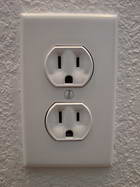The Process for removing the tab link from the outlet |
|
| This series of electrical wiring pictures shows how the actual wiring is attached using the top wiring diagram scenario #1 where the power enters at the switch box and a 3-wire romex runs from the switch box down to the grounded wall outlet. | |
 |
Step OneThe circuit has been positively identified and the power has been shut off. A note has been placed to let others know that there is work being done on the circuit. |
 |
Step TwoRemove the caps or wire nuts off of the wires. Strip the insulation from the insulated wires according to the strip gauge on the back of the outlet. Use you wire strippers or pliers to make a hook on the end of the ground wire so it can be attached to the ground screw of the outlet. |
 |
Step ThreeHere is the bridge or tab that joins the upper and lower sections of the power side of the outlet together. This is a flat brass piece of metal. |
 |
Step FourBy using a pair of needle nose pliers you can grip the flat tab of metal and with a side to side motion wiggle it back and forth until it breaks off. Side cutters are sometimes used but that can leave the metal in place or sticking out where it can become a problem. |
 |
Step FiveHere the tab is removed and now the top and bottom outlets are separated from one another. |
 |
Step SixNotice that the two separate colored wires, red for the light fixtures which is controlled by the switch and the black for the bottom outlet which is hot all the time. Notice that I have used the quick connect because the lighting load is small. If the load was greater then I would have attached the wires to the screw terminals on the side. |
 |
Step SevenThe wiring is folded back into the outlet box being careful that the ground wire is not near the screws of the outlet's hot or neutral side. |
 |
Step EightUse the outlet mounting screws to secure the outlet firmly to the wall adjusting the outlet from side to side as necessary, depending on how well of a job the sheet rockers have done. |
 |
Step NineMount the cover plate in place, notice the opening to the box is complete covered up. This electrical project is complete and ready for the power to be restored to the circuit. |
» Home Electrical Wiring
» Electrical Wiring Directory
» How to Wire a Wall Receptacle Outlet
» Need Electrical Help? Ask the Electrician
» How to Wire a Wall Receptacle Outlet
» Need Electrical Help? Ask the Electrician
How to Wire A Switched Outlet

|
Summary: Step-By-Step Procedure that must be performed for Switch wed Outlets to Function. One very important element can be easily overlooked as you will see in these pictures.
© By: Dave Rongey |
Switched Outlet Wiring and Tab Removal Procedure
This electrical picture series shows the vital procedure that must be performed in order for the switched outlet to work. If this procedure is not done then the most typical problem will be that both upper and lower outlet will be hot instead of one being controlled by the wall switch.
When this procedure is done correctly it will produce a switched outlet also known as a Half Hot Plug. This procedure shows how the outlets have the tab removed from the "hot" side or Brass side of the outlet which allows the top half of the plug to be controlled only from the switch while the bottom end of the outlet remains "hot" all the time. This is shown in the pictures below.
The Safest Way to Test Electrical Devices and Identify Electric Wires!The Non-Contact Electrical TesterThis is a testing tool that I have had in my personal electrical tool pouch for years, and is the first test tool I grab to help identify electrical wiring. It is a Non-contact tester that I use to easily Detect Voltage in Cables, Cords, Circuit Breakers, Lighting Fixtures, Switches, Outlets and Wires. Simply insert the end of the tester into an outlet, lamp socket, or hold the end of the tester against the wire you wish to test. Very handy and easy to use.
The Quickest Way to Check for Faulty Electrical Wiring!The Plug-In Outlet TesterThis is the first tool I grab to troubleshoot a problem with outlet circuit wiring. This popular tester is also used by most inspectors to test for power and check the polarity of circuit wiring. It detects probable improper wiring conditions in standard 110-125 VAC outlets Provides 6 probable wiring conditions that are quick and easy to read for ultimate efficiency Lights indicate if wiring is correct and indicator light chart is included Tests standard 3-wire outlets UL Listed Light indicates if wiring is incorrect Very handy and easy to use.
Strip Off Wire Insulation without Nicking and Damaging the Electric Wire!The Wire Stripper and Wire CutterMy absolute favorite wire stripping tool that I have had in my personal electrical tool pouch for years, and this is the tool I use to safely strip electrical wires. This handy tool has multiple uses: The wire gauges are shown on the side of the tool so you know which slot to use for stripping insulation. The end of the tool can be used to grip and bend wire which is handy for attaching wire onto the screw terminals of switches and outlets.. The wire stripper will work on both solid and stranded wire. This tool is Very Handy and Easy to Use. |
||
Outlets Parts and Accessories120volt Wall Outlet GFCI Outlet Switch and Outlet Combo |















